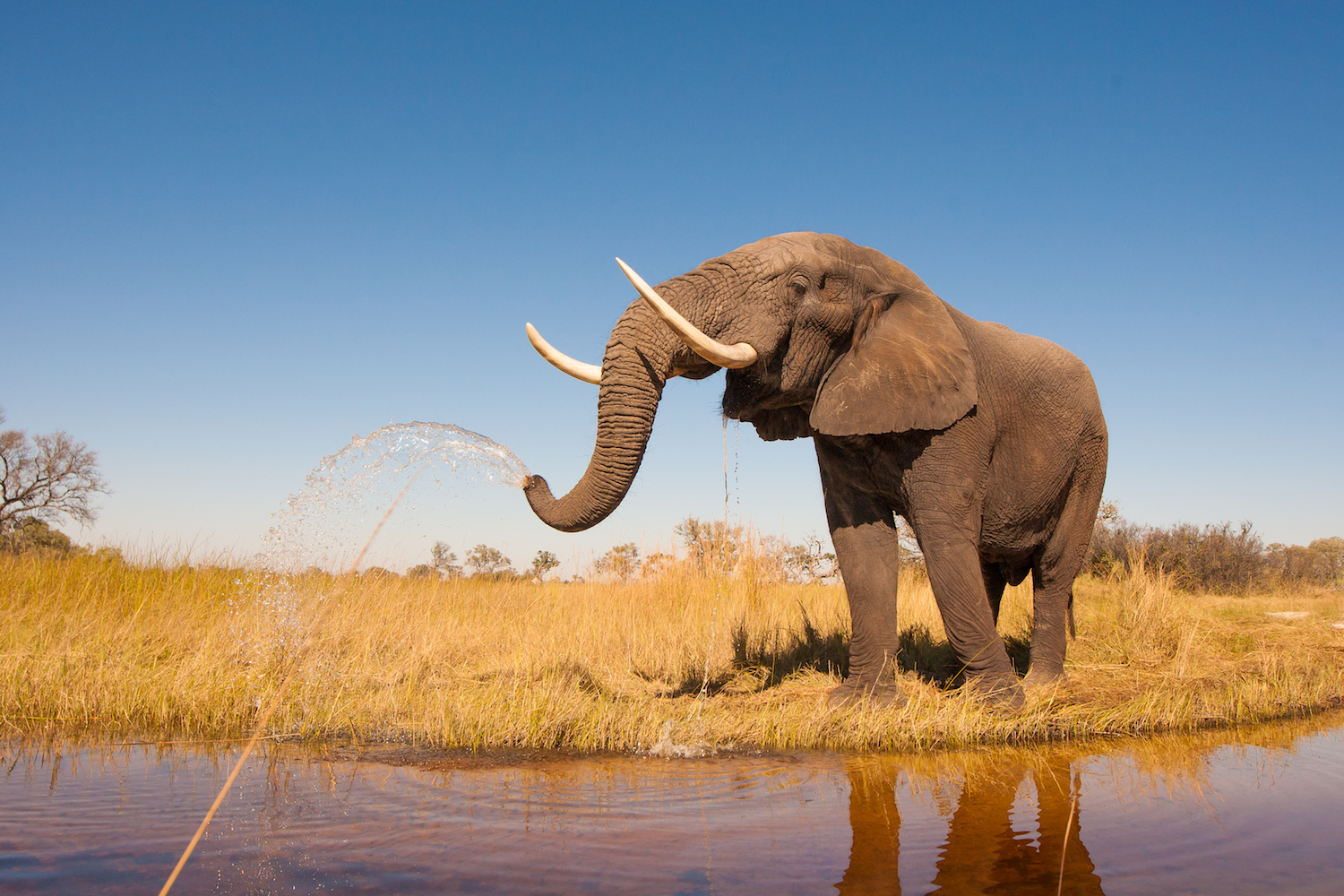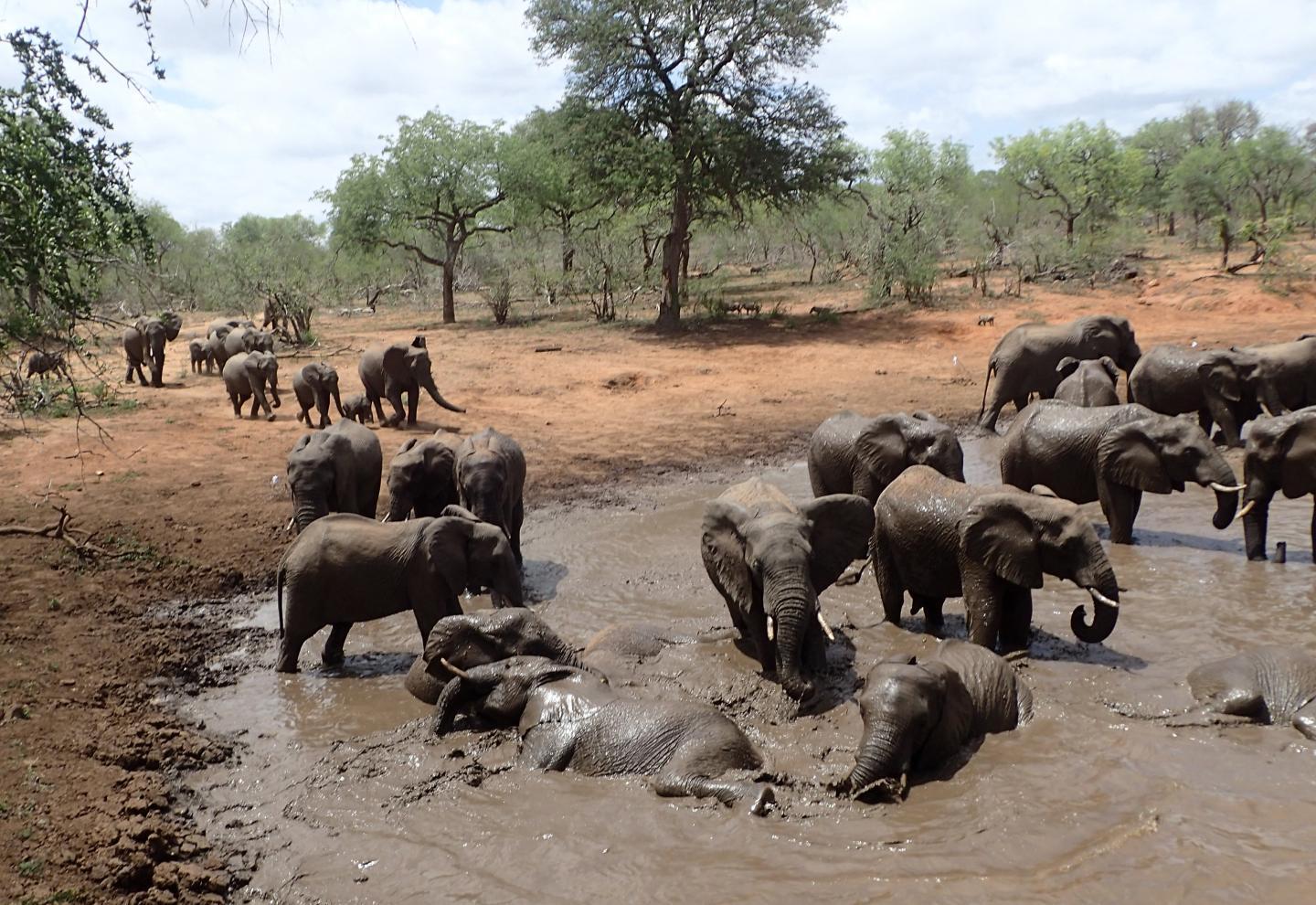Baby Elephant and Adult Elephant Breakout From Jail
Elephants: Earth'southward Largest Living Land-Animals

Elephants are the largest land animals on Earth, and they're one of the most unique-looking animals, too. With their characteristic long noses, or trunks; large, floppy ears; and wide, thick legs, there is no other animate being with a similar physique.
Most experts recognize 2 species of elephant: the Asian elephant (Elephas maximus) and the African elephant (Loxodonta africana), who live on separate continents and have many unique features. There are several subspecies that belong to one or the other of these two master species, though experts fence over how many subspecies there are and whether or not they constitute carve up species, co-ordinate to the San Diego Zoo.
African and Asian elephants
African elephants live in sub-Saharan Africa, the rainforests of Central and West Africa and the Sahel desert in Mali, according to National Geographic. Asian elephants live in Nepal, India and Southeast Asia in scrub forests and rainforests. [Elephant Images: The Biggest Beasts on State]
African elephants are the larger of the two species. They grow to between 8.2 and 13 feet (2.v and iv meters) tall at the shoulder and weigh 5,000 to fourteen,000 lbs. (ii,268 to vi,350 kilograms), according to National Geographic. Asian elephants are just a little smaller, growing to between six.6 and ix.eight feet (2 and 3 yard) alpine at the shoulder and weighing between iv,500 and 11,000 lbs. (2,041 and 4,990 kg). In the wild, African elephants tin live upwardly to 70 years, and Asian elephants up to 60 years.
African and Asian elephants also have a few unlike physical features.
The ears of African elephant are larger and resemble the shape of the African continent, while Asian elephants have smaller, rounder ears, according to the San Diego Zoo.
Both male and female African elephants have large tusks and two "fingers" on the finish of their trunks to help them pick items up. Asian elephants have a single "finger" on the end of their trucks. Only typically, merely male person Asian elephants will grow large tusks, while the females and a few males have much smaller tusks called tushes that don't always abound outside the mouth.
Tusks are large, securely rooted teeth that evolved to assist the elephant in digging, lifting, gathering food, and defense while besides protecting the torso, according to World Wildlife Fund. In the same way that humans tend to be right-handed or left-handed, elephants tin can exist right-tusked or left-tusked. Their ascendant tusk is like shooting fish in a barrel to place, because it will be more than worn down than the less ascendant tusk, according to the Earth Wildlife Fund.
Both species consume all types of vegetation, including a variety of grasses, fruits, leaves, bark and roots. They spend nearly well-nigh xvi hours eating, consuming anywhere from 165 to 330 lbs. (75 to 150 kg) of food per day, according to the San Diego Zoo.

Elephant life
Groups of elephants, or herds, follow a matriarchal structure with the eldest female in charge. Herds are composed of primarily female family members and young calves, according to the San Diego Zoo, and include 6 to 20 members depending on the nutrient supply. When the family gets too large, herds ofttimes split into smaller groups that stay within the same surface area.
The matriarch relies on her feel and memory to recall where the best spots for food, water are, and where to find protection from the elements. The matriarch is also responsible for teaching the younger members of her family how to socialize with other elephants.
Elephants are very social and tin can communicate with one another and identify other elephants from distances of up to 2 miles using rumbling, low-pitched sounds that autumn below the audible range of humans, according to the National Zoo.
Elephants readily show good manners to members within its herd and other herds, co-ordinate to the San Diego Zoo. For example, they employ their trunks to greet one another, either past property it out high or by inserting the end of their body into another elephant's mouth.
Elephants also pay close attention to the well-being of all the members of their herd, and volition do what they tin can to have intendance of and protect weak or injured members.
They're considered an extremely intelligent species, and take been observed showing advanced problem-solving skills and demonstrating empathy, mourning and self-awareness, according to an commodity in Scientific American.

Next generation
Male and female elephants become sexually mature between 8 and 13 years of age. Male elephants volition go out their herd around this time, equally long as they're able to find their ain food and protect themselves, according to the Smithsonian National Zoo. Adult males either live on their own or in small-scale available herds.
Females may not have their first calf until their heart teen years, while males may not father a calf until they are in their 30s, when they are big and potent enough to compete with other males, co-ordinate to the National Zoo.
Usually, only a single dogie is born following a 22-month pregnancy. A newborn calf weighs between 150 and 350 lbs. (68 and 158 kg) stands about three feet tall. Calves besides tend to be hairy with long tails and very short trunks.
Elephant calves abound apace, gaining two to 3 lbs. every day in their first year, according to the San Diego Zoo. By the time they are 2 or iii years old, calves are ready to exist weaned.

Classification/Taxonomy
All elephants are mammals belonging to the elephantidae family. In that location are two subspecies of the African elephant: the savanna (or bush-league) elephant (Loxodonta africana) and the wood elephant (Loxodonta cyclotis). Notwithstanding, wood elephants may in fact exist a singled-out species of elephant instead of a subspecies, according to Cornell University.
At that place are three subspecies of Asian elephant: the Indian elephant (Elephas maximus indicus), the Sri Lankan elephant (Elephas maximus maximus), and the Sumatran elephant (Elephas maximus sumatranus). Another possible subspecies is Elephas maximus borneensis (Kalimantan pygmy elephant). The World Wild animals Fund has adamant that Dna evidence suggests that the Borneo pygmy elephant is genetically different from other Asian elephants.
Conservation status
The International Union for Conservation of Nature and Natural Resources (IUCN) classifies the Asian elephant as endangered. Though it is not known exactly how many Asian elephants remain, experts believe that the population is decreasing.
The African elephant is considered vulnerable, according to the IUCN, and the species' population is increasing. Co-ordinate to the African Wild animals Foundation, there are around 415,000 African elephants in the wild.
Threats against the survival of both African and Asian elephants include poaching and habitat loss, according to Earth Wildlife Fund.
Additional resources:
- Check out more interesting facts about African elephants on the Elephants for Africa website.
- Acquire more about elephant conservation from the International Elephant Foundation.
- See the ambrosial baby elephants beingness cared for at Elephants Without Borders elephant orphanage in Botswana.
This article was updated on March eighteen, 2019, by Live Science Correspondent Rachel Ross.
Source: https://www.livescience.com/27320-elephants.html

0 Response to "Baby Elephant and Adult Elephant Breakout From Jail"
إرسال تعليق